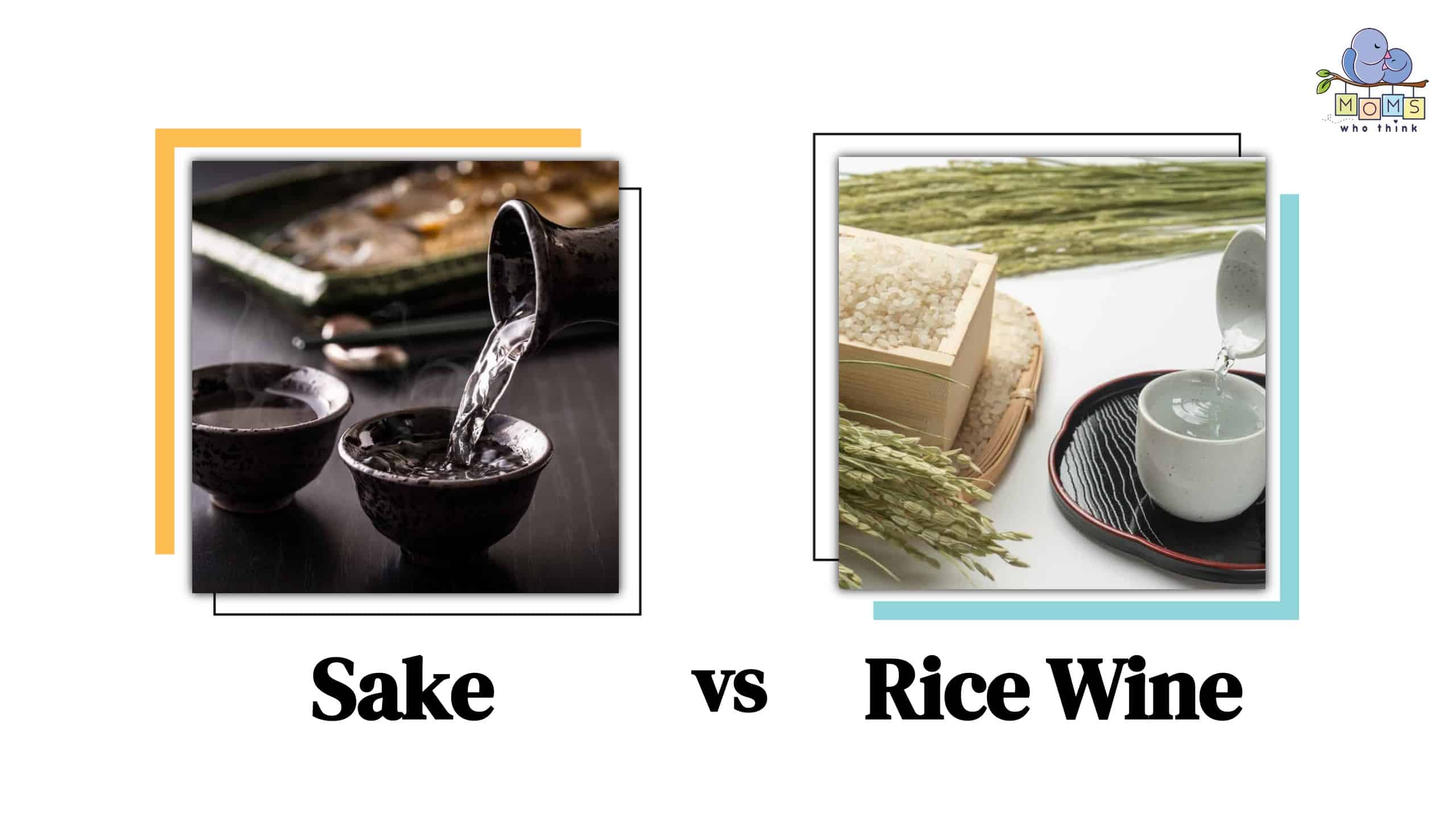Sake vs. Rice Wine: People commonly mistake sake for wine hence being given the international moniker of “rice wine.” Additionally, because of its alcohol content and appearance, people often interchange the two beverages.
All sake comes from rice, which they sell in huge bottles. However, sake, like beer, undergoes a brewing process.
Sake is its own drink classification since it employs a unique rice fermentation technique that distinguishes it from wines and other alcoholic drinks, giving it a distinct taste, aroma, and food-matching experience.
In this article, we will learn about all the differences you need to know about sake vs. rice wine, so keep reading!
Sake vs. Rice Wine: What Are Their Differences?
Sake and rice wine are words that sometimes mean the same thing, but they actually describe different kinds of alcoholic drinks. You can make them in different ways, and they come from different cultures. Let's look at the main ways sake and rice wine are different:
Taste
Sake has considerably more acidity than rice wine and may range from a dry to a sweet taste. The light umami taste of the beverage came from the amino acids, and a few kinds of sake even include fruit flavors.
While rice contributes to the flavor of sake and rice wine, the impact of koji and yeast is more pronounced in sake. While you can use koji and yeast to make rice wines, the addition of different microbial organisms during the fermentation process also impacts the beverage's flavor.
- The must-have convenient reference guide for every home cook!
- Includes more than 8,000 substitutions for ingredients, cookware, and techniques.
- Save time and money on by avoiding trips to grab that "missing" ingredient you don't really need.
According to many people, Sake has an explicit, crisp note with a faint umami flavor. Rice wine, on the other hand, has a richer mouthfeel and a more noticeable sweetness.
So in terms of having a sweet yet subtle flavor, rice wine wins.
Processing
While rice wine goes through a single fermentation process, you produce sake by using a two-step fermentation process.
This two-step fermentation procedure easily breaks down rice. Yeast converts rice starch to sugar, which is ultimately turned into alcohol. As a result, the sake production method seems more comparable to beer than wine. The technique of “multiple parallel fermentation” is specific to saké brewing, and the end product of 20% ABV makes saké the fermented beverage with the greatest naturally generated alcohol concentration in the world.
Both beverages have yeast as an ingredient. However, in wine production, sugar is already present in the fruit pulp for the yeast to absorb. In a nutshell, no specific mold is necessary during the winemaking process. The mold is what distinguishes sake.
Alcohol content
Sake is slightly more potent than most wines. Diluted sake contains about 15% or 16% alcohol by volume (ABV), placing it among the most popular alcoholic beverages. Undiluted sake, on the other hand, has an ABV of roughly 18%-20%.
Rice wine has around 9-16% alcohol by volume.
Ingredients
You can prepare rice wine from different kinds of rice, and the method of making it may include spices, aromatics, or any fermentable components. On the other hand, you make sake from specifically produced sake rice, water, yeast, and koji mold.
Sakamai is rice that is utilized in the production of sake. These are bigger grains than regular white rice and have a white center and less protein content, with the better types having a sticky texture.
Rice used to produce rice wine could differ, and it is not always as completely polished as the rice used for producing sake.
Sake vs. Rice Wine: Nutritional Value
When comparing the nutritional value of sake and rice wine, some differences become apparent. Firstly, sake is typically lower in calories and carbohydrates compared to rice wine. This is because sake undergoes a fermentation process that converts much of the rice's sugar into alcohol. As a result, sake has a relatively lower carbohydrate content. Additionally, the fermentation process also produces small amounts of amino acids and minerals, providing some nutritional value.
On the other hand, rice wine tends to have a higher calorie content and may contain more carbohydrates than sake. The production of rice wine involves a fermentation process where yeast or other microorganisms convert the starches in the rice into alcohol. Due to the fermentation process being less controlled compared to sake production, rice wine may contain a higher residual sugar content, contributing to its higher calorie and carbohydrate levels.
Furthermore, rice wine can also contain some vitamins and minerals, depending on the specific type and production process. These nutrients may vary based on the ingredients used and any additional fortification. However, it is worth noting that the overall nutrient content of rice wine might be relatively limited compared to other food sources.
As with any alcoholic beverage, it's crucial to consume sake and rice wine in moderation, considering their nutritional content and personal dietary needs. It's advisable to be aware of the potential impact on overall calorie and carbohydrate intake while also ensuring a balanced diet with a variety of nutrient-rich foods.
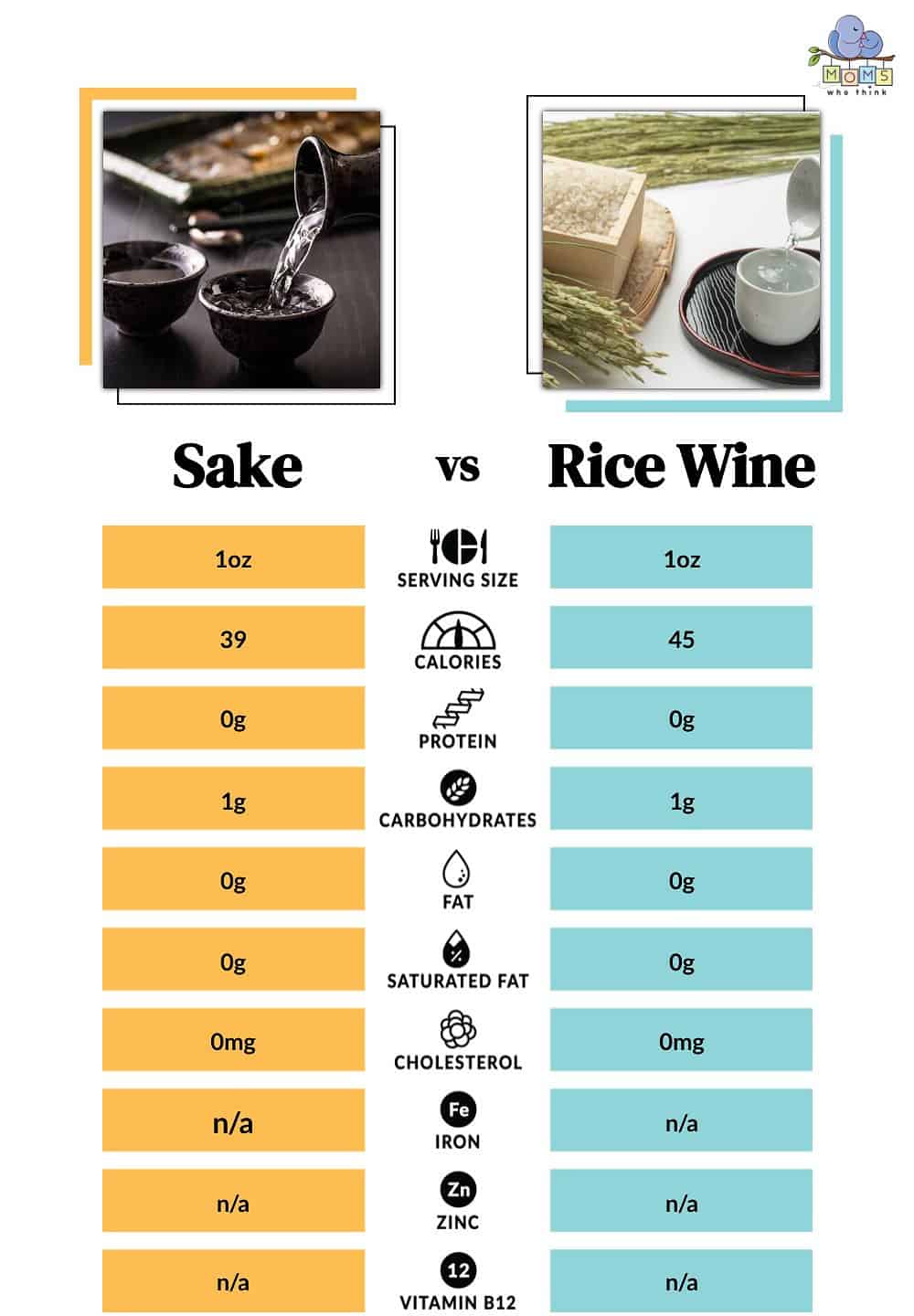
What is Sake?
Sake, pronounced “sah-keh,” is an alcoholic drink that Japan manufactures using fermented rice. “Sake” is also a broad term for any alcohol-based beverage in Japan.
Additionally, since worldwide appreciation for Japanese cuisine has increased, sake has become a popular and well-known beverage.
Good sake is produced on a base of high-quality rice, pure water, koji mold, and yeast. They are mixed and fermented using methods that ancient people used throughout the years.
Sake's two-step fermentation process distinguishes it from other types of fermentation. The starches found in rice are first converted into sugars; subsequently, those sugars are converted into alcohol. This process gives sake its particular flavor and scent.
Additionally, Saké has the highest concentration of amino acids in any alcoholic beverage. Saké has seven times more amino acids than wine. Amino acids serve as flavor enhancers and spices in meals all over the world to make them taste more delectable and distinctive.
What is Rice Wine?
Rice wine is known traditionally as “xaj-pani” by the Ahoms people from Assam. Rice wine is a general term for alcoholic drinks manufactured in East Asia from grains, primarily rice. In the West, people know the beverage as ‘rice wine' because it has an alcohol concentration similar to that of wine.
Rice wine, in any form, is a sweet alcoholic beverage popular in meals and cocktails. It can also serve as a flavoring agent in marinating sauces or sauces such as teriyaki.
There are several varieties of rice wines, although Huangjui and Baijui are two that are well-known in China. Baijui undergoes distillation, whereas Huangjiu goes through fermentation.
- The must-have convenient reference guide for every home cook!
- Includes more than 8,000 substitutions for ingredients, cookware, and techniques.
- Save time and money on by avoiding trips to grab that "missing" ingredient you don't really need.
Best Food Match for Sake
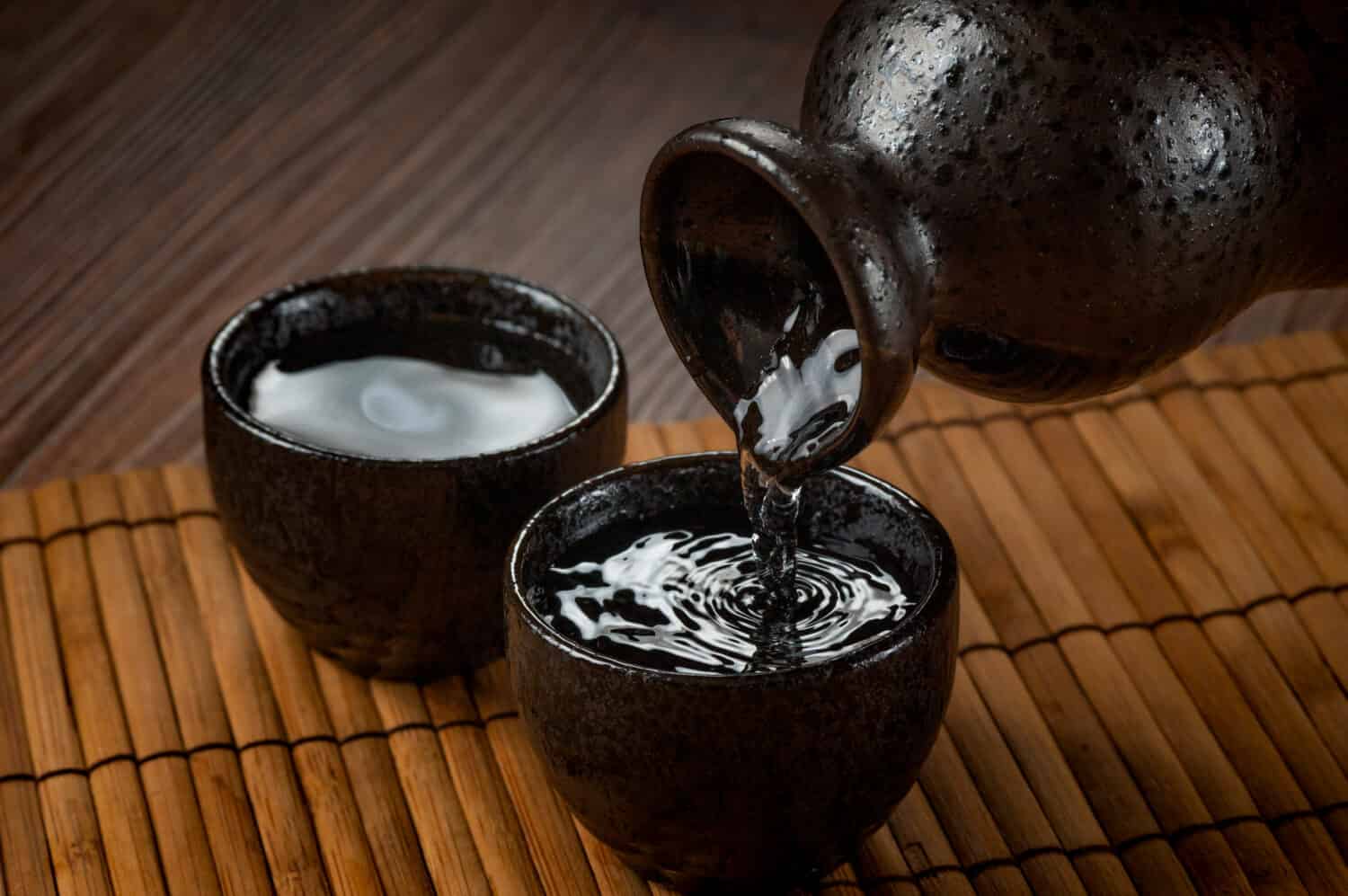
Sake is made using fermented rice.
©Chiristsumo/Shutterstock.com
One of the best parts of picking up some fresh bottles of sake is planning what you would pair it with. Here are some foods you certainly will enjoy for a good sake night:
Ramen
Alongside a steaming bowl of ramen and a matching sake, Japanese people have mourned, chatted, and connected for hours and hours. Sake not only complements the flavorful bowl of Japanese noodle perfection, but it nearly seems to round out the feast.
Chocolate
When it comes to desserts, chocolate isn't the first thing that comes to mind when attempting to pair sake with something sweet. Regardless, choosing a sake with the correct balance of sweetness, acidity, and mouthfeel will enhance your chocolate pleasure to the fullest.
Thai Food
Thai cuisine pairs beautifully with crisp, sweet sakes owing to its complex blend of salty, sour, sweet, and bitter qualities. It is rich in umami and flavor and is best paired with milder sake with fruity and flowery flavors.
A dry, rich sake, with its powerful texture and great complexity, may accompany pungent spicy or hot meals. Spices, herbs, and chile may overpower our taste buds. Therefore the great complexity and intensity of a rich sake might help to balance things out.
Best Food Match for Rice Wine
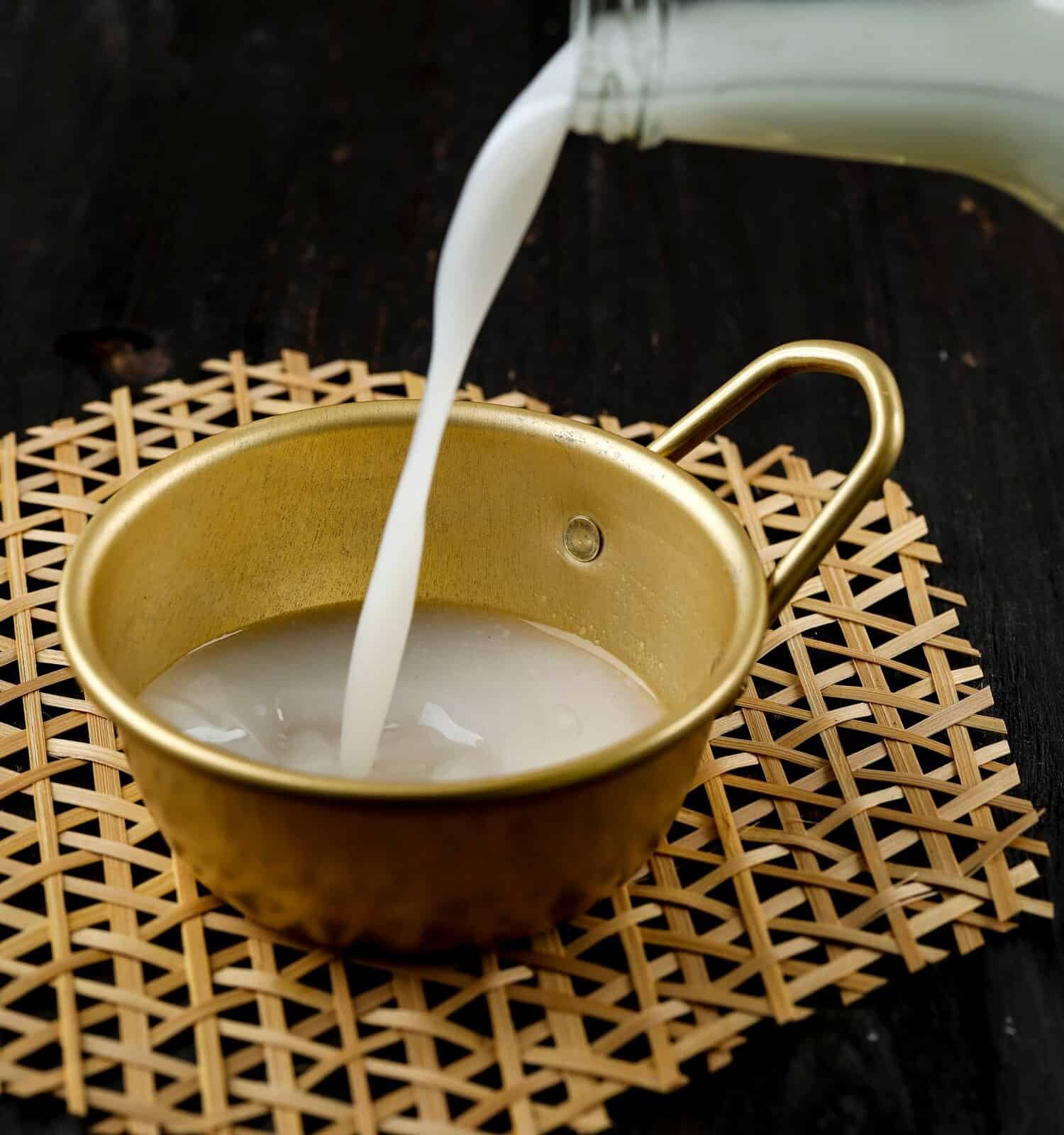
Rice wine, in any form, is a sweet alcoholic beverage popular in meals and cocktails.
©Ika Rahma H/Shutterstock.com
The fact that this wine turns out to be versatile is something that many people find surprising. Rice wine is famous for being capable of enhancing a variety of dishes due to its versatility in terms of pairing with a broad range of distinct flavors, textures, and food groups. Below are some of the foods that complement rice wine beautifully:
Barbeque
BBQ is a flavorful and distinctive food that is suitable for any occasion and goes well with this drink. If the BBQ flavor is light, we recommend selecting a fruity wine, like a Sauvignon Blanc. A stronger and more powerful wine, such as Zinfandel, would be more suitable if the Korean BBQ has a spicy kick to it.
Korean Pancakes
Korean pancakes are frequently served with Korean rice wine in Korea. White wines with strong acidity and a unique olfactory character complement the acidic tastes of Kimchi Pancakes well.
The rice wine contains just 6% alcohol and is a good source of protein and vitamin B while giving off a tart kick to the dish.
Fruits and cheese
Cheese, like most other wines, tastes fantastic when served alongside rice wine. Melon and fruits also pair well with sake because their tastes combine on different scales throughout the course of the meal. The dish provides a cooling element, and the sake's mouthwatering taste profile completes the sweet notes.
Can I use sake instead of rice wine?
You may substitute sake as a substitute for rice wine. Some people refer to sake as rice wine, although it is actually closer to beer. Just like rice wine, it may be used for both cooking and drinking. Sake works well with marinating sauces and stews.
Which is more effective for cooking?
Japanese sake tastes significantly different from rice wine from other nations such as China. Some cooks, though, enjoy it and use it more frequently. A wine could be very potent and sweet and could overpower the other flavors in your dish, but it really boils down to personal taste and the dish you are trying to create.
Final Thoughts
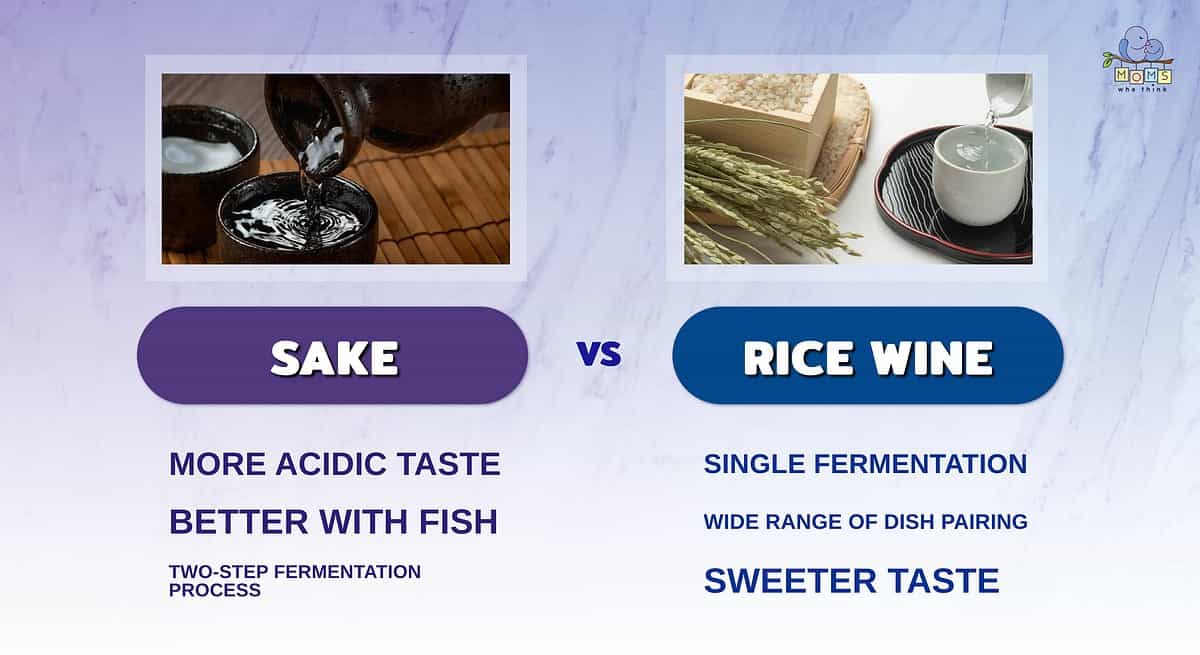
- Rice wine generally has a sweeter taste than sake.
- There are dozens of different types of sakes while rice wine has hundreds depending on the region.
- Sake needs a two-step fermentation process while rice wine needs only one.
Although both sake and wine are both alcoholic drinks, they differ significantly in terms of their components, production process, flavor profile, and uses.
Despite being commonly referred to as “rice wine,” it is not considered a wine because it is prepared using a brewing and fermenting procedure that is comparable to beer.
Sake and rice wine are identical terms among the Japanese. Rice wines can be either distilled or fermented. However, to make sake, it must only undergo a specific fermentation. On the surface level, they are comparable, yet the procedures used for producing rice wine and sake are distinct from one another.
In simple terms, sake is sake, and rice wine is wine.
We hope you're encouraged to try both of these delightful beverages after getting the gist of their differences. Discovering and enjoying the distinct characteristics of both beverages may be a pleasurable voyage of food exploration.
This delicious stir-fried lemon shrimp and asparagus recipe uses rice wine:
Print
Stir-Fried Lemon Shrimp and Asparagus
- Yield: Serves 4
Ingredients
1 pound extra-large shrimp (21 to 25 per pound), peeled and deveined
2 teaspoons low-sodium soy sauce
2 teaspoons Chinese rice cooking wine or dry sherry
3 scallions, minced
3 garlic cloves, minced
1 tablespoon grated fresh ginger
5 teaspoons canola oil
1 bunch asparagus (about 1 pound), tough ends trimmed, sliced on the bias into 2-inch lengths
2 carrots, peeled and cut into matchsticks
6 tablespoons low-sodium chicken broth
1/4 cup fresh lemon juice from 2 lemons
1/4 cup Chinese rice cooking wine or dry sherry
2 tablespoons low-sodium soy sauce
2 teaspoons sugar
2 teaspoons cornstarch
1/4 teaspoon pepper
Instructions
1. Toss the shrimp with 2 teaspoons each soy sauce and rice wine in a bowl and marinate for at least 10 minutes or up to 1 hour.
2. Combine the scallions, garlic, ginger, and 1 teaspoon of the oil in a bowl.
3. Heat 2 teaspoons more oil in a 12-inch nonstick skillet over high heat until just smoking. Add the shrimp, break up any shrimp that stick together, cook until lightly browned on all sides but not fully cooked, about 1 ½ minutes. Transfer to a bowl, cover, and set aside.
4. Add the remaining 2 teaspoons oil to the skillet and return to high heat until shimmering. Add the asparagus and carrots and cook until the vegetables are crisp-tender, 3 to 4 minutes.
5. Clear the center of the skillet, add the garlic mixture, and cook, mashing the mixture into the pan, until fragrant, 15 to 30 seconds. Stir it into the vegetables.
6. Return the shrimp, with any accumulated juice, to the skillet. Whisk remaining ingredients together in a bowl, then add to skillet. Simmer, tossing constantly, until the shrimp are cooked through and the sauce has thickened, 30 seconds to 2 minutes. Serve.
- The must-have convenient reference guide for every home cook!
- Includes more than 8,000 substitutions for ingredients, cookware, and techniques.
- Save time and money on by avoiding trips to grab that "missing" ingredient you don't really need.
Nutrition
- Serving Size: 1¼ cup
- Calories: 230
- Sodium: 560mg
- Fat: 8g
- Carbohydrates: 17g
- Fiber: 4g
- Protein: 21g
- Cholesterol: 130mg
